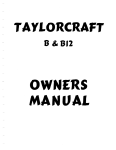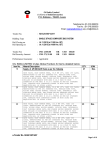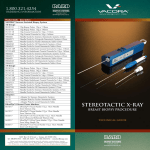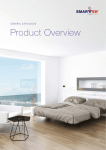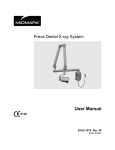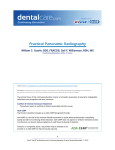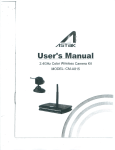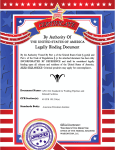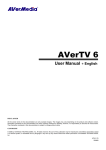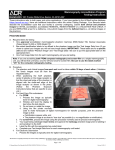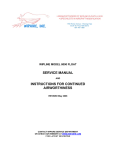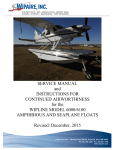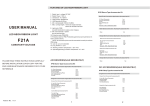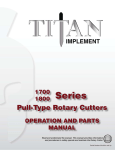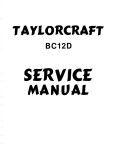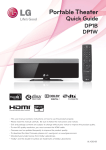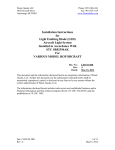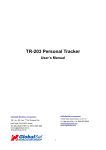Download SB2007-001 Issue B (15 Oct 2007)
Transcript
Taylorcraft Aviation, LLC Service Bulletin No. 2007-001 2124 Central Ave Date: October 15, 2007 Brownsville, TX 78521 Taylorcraft Considers Phone (956) 986-0700 Compliance Mandatory Fax (956) 986-0709 __________________________________________________________________ Revision: B (Add: X-Ray as approved Inspection, Remove Eddy Current as Approved inspection; Extended Recurring Inspection Intervals) SUBJECT: Wing Lift Strut Assembly Corrosion Inspection/Replacement. PURPOSE: The actions specified by this Service Bulletin are intended to inspect for and detect any internal or external corrosion of the wing lift strut tube, and thereby prevent wing strut failure and inflight separation of the wing from the airplane resulting in loss of control of the airplane. The corrosion is most likely to occur at the lower end of the left and right wing aft and forward lift struts (near the fuselage attachment). Since the lift struts are closed tubular structures, internal corrosion in most cases is not readily apparent until the corrosion advances through the tube wall. This corrosion, if allowed to progress, may lead to failure of the wing lift strut, and probable loss of wing structure integrity. This Service Bulletin provides an inspection procedure to detect evidence of wing lift strut tube internal and external corrosion. FOR FURTHER INFORMATION ACCESS WWW.TAYLORCRAFT.COM OR CONTACT: Engineering Department 956-986-0700 ext: 17 [email protected] Parts Department 956-986-0700 ext: 14 or 15 [email protected] EVENTS LEADING TO THE ISSUANCE OF THIS SERVICE BULLETIN: Taylorcraft has received field reports of front and rear lift strut corrosion located within the bottom 12 inches of the struts. The corrosion can be severe enough that in some cases in-flight failure of the lift strut(s) may occur. APPLICABILITY: All Taylorcraft Aviation Airplane Models listed on Type Certificates A-696 and 1A9, to include the following airplane models, certificated in any category: BC, BCS, BC-65, BCS-65, BC12-65, BCS12-65, BC12-D, BCS12-D, BC12-D1, BCS12-D1, BC12D-85, BCS12D-85, BC12D-4-85, BCS12D-4-85, 19, F19, F21, F21A, F21B, F22, F22A, F22B, F22C. www.taylorcraft.com 1 of 14 Taylorcraft Aviation, LLC Service Bulletin 2007-001 NOTE: This Service Bulletin applies to each airplane identified in the preceding applicability provision, regardless of whether it has been modified, altered, or repaired in the area subject to the requirements of this Service Bulletin. For airplanes that have been modified, altered, or repaired so that the performance of the requirements of this Service Bulletin is affected, the owner/operator must request approval for an alternative method of compliance. The request should include an assessment of the effect of the modification, alteration, or repair on the unsafe condition addressed by this Service Bulletin; and, if the unsafe condition has not been eliminated, the request should include specific proposed actions to address it. COMPLIANCE: Perform Part 1 of the INSTRUCTIONS within the next thirty (30) calendar days. Perform Part 2 of the INSTRUCTIONS within the next three (3) calendar months; except, when corrosion is found during Part 1 of the INSTRUCTIONS, you must perform Part 2 of the INSTRUCTIONS prior to further flight. Re-inspect struts every forty-eight (48) months in accordance with Part 2 of the INSTRUCTIONS. NOTE: If the wing lift struts are new and have been installed within the last forty eight (48) months, inspection is required no later than forty-eight (48) months after the time the new lift struts were installed. TERMINATING ACTION: Installation of new replacement sealed front lift strut, (Part number MA-A815), or new replacement sealed aft lift strut, (Part number MA-A854), is considered terminating action for the repetitive forty-eight (48) month inspections. Note that if not all lift struts are replaced with new sealed units, the struts that are not replaced shall be re-inspected at forty-eight (48) month intervals. PERSONNEL REQUIREMENTS: The inspection procedures in Appendix A and B must be accomplished by a Level II or Level III inspector certified in the applicable Ultrasound or Radiographic Inspection method using the guidelines established by the American Society of Nondestructive Testing or NAS 410 (formerly MIL-STD-410), or an Inspector certified to specific FAA, or other acceptable government or industry standards, such as Air Transport Association (ATA) Specifications 105-Guidelines for Training and Qualifying Personnel in Nondestructive Testing Methods, or qualified FAA Repair Station, or a qualified Testing / Inspection Laboratory. The person should be familiar with the test methods, know the potential types of discontinuities peculiar to the material, and be familiar with their effect on the structural integrity of the part. An ASNT Level III Inspector certified in radiography may adjust the procedure to fit the equipment they are using in Appendix B. www.taylorcraft.com 2 of 14 Taylorcraft Aviation, LLC Service Bulletin 2007-001 INSTRUCTIONS: Part 1 1. Clean the lower eighteen (18) inches of the right and left wing forward and aft lift struts with a suitable cleaner to remove all dirt and grease (strut removal is not required). 2. Visually inspect the right and left wing forward and aft lift struts for corrosion or cracks along the entire bottom twelve (12) inches of each strut. If, at any point, there is corrosion penetrating the entire thickness of the lift strut material, the strut should be replaced before the next flight. Clean the drain hole using safety wire or an equivalent thin gauge probe and observe any indications of internal rust. 3. If any signs of corrosion, cracks, blistered paint, pitting, etc. of the lift strut material is observed, or, if during the removal and installation of the lift struts for other maintenance loose rust is heard or discovered inside the lift struts, perform Part 2 of these instructions prior to further flight. Part 2 1. Level the aircraft so that the lower surface of the wings is as close to level with the ground as possible. Ideally, support the rear fuselage on a well padded sawhorse or secure stand under the rear fuselage a foot or so forward of the tailwheel. Support and restrain the aircraft from movement using wheel chocks, tiedowns, etc. so that the aircraft is secure in both fore-aft rolling and tail-swing directions. Failure to properly accomplish this can lead to damage in later steps. 2. Support the weight of the outer wings so they will not drop when the strut bolts are removed. Using a marker pen, mark the four struts with their correct position on the aircraft. 3. Carefully remove the lower strut attach nut, and remove the bolt. Put the hardware in a tray or plastic bag for later inspection. Verify that the outer wing supports are holding the wings from moving. The wings cannot be allowed to move in order to prevent stresses or damage to the aileron control circuit, which is still under flight tension. 4. When the wings are verified to be secure, remove the upper strut attach bolts, and carefully remove the struts. Be sure to remove the lower portion of the struts from the fuselage carefully, and without any fore-aft movement so the strut mounting tabs are not bent. It is suggested to have a helper, both for holding the weight of the strut and preventing this fore-aft movement so you can pull the strut out in a straight movement. 5. Visually inspect the wing strut attachment fittings on each side of the fuselage for signs of cracking or corrosion. Clean any dirt or debris from the area around the attach fittings using suitable cleaning solution and soft bristle brush to facilitate inspection. 6. Turn each lift strut upside down and tap gently to remove any water, debris, or corrosion particles. Clean the lower eighteen (18) inches of each lift strut with a suitable cleaner to remove all dirt and grease. www.taylorcraft.com 3 of 14 Taylorcraft Aviation, LLC Service Bulletin 2007-001 7. Perform the inspection of the lower twelve (12) inches of the strut in accordance with the inspection procedure in Appendix A (Ultrasound inspection) or Appendix B (Radiographic inspection). 8. Verify suspected corrosion areas using a second inspection method in the appendix. 9. If no external corrosion is visible and inspection results using Appendix A or B procedure are acceptable per ACCEPTANCE/REJECTION CRITERIA below, apply corrosion inhibitor to the inside of each lift strut in accordance with CORROSION INHIBITOR PROCEDURE below. 10. Replace any strut having severe internal or external corrosion or that fails inspection using the ACCEPTANCE/REJECTION CRITTERIA below. Install new sealed wing lift struts, part numbers MA-A815 (front) and MA-A854 (rear). 11. Reinstall reusable lift struts on same side removed per LIFT STRUT WING LEVELING PROCEDURE. 12. After inspection it may be necessary to repair/touch up external painted surfaces of the strut surface to prevent future corrosion. 13. Acceptable struts will require a unique identifier be applied to them for future record keeping and tracking. Rejected struts require tagging or permanent mutilation for future inspection or scrapping. 14. Generate a report for inclusion in the aircraft history file to allow a log-book entry by the proper authority, in compliance with applicable regulations. SUPPLEMENTARY INFORMATION: 1. NDT inspection of the lift struts requires removing them from the airplane and testing them on a flat, level surface. In the process of removing the lift struts, please mark each one, and upon passing inspection reinstall it in the same position that it was removed from (i.e. the lift strut removed from the left rear position must be reinstalled on the left rear position, and not on the right rear position). 2. Replacement lift struts are available from the factory and terminate the recurring inspection requirement. When ordering, please use the following part numbers: MA-A815 MA-A854 Front Lift Strut Rear Lift Strut www.taylorcraft.com 4 of 14 Taylorcraft Aviation, LLC Service Bulletin 2007-001 ACCEPTANCE/REJECTION CRITERIA: 1. The following criteria shall be used for rejection and require replacement of the strut prior to further flight: a. Any strut with corrosion through the thickness of the part b. Any strut with cracks c. Any strut exhibiting multiple pitting sites over a concentrated area d. Any strut with corrosion that results in a remaining wall thickness of 0.020” or less over more than one (1) square inch of the total surface area e. Any strut with corrosion evident over 30% or more of the required inspected surface area that results in a remaining wall thickness less than shown in the table below: Strut thickness (inch) 0.035 +/- 0.004 0.042 +/- 0.004 0.049 +/- 0.004 Minimum allowed thickness (inch) 0.029 0.035 0.041 2. If at any time during testing an area is encountered where a valid thickness measurement cannot be obtained due to a loss of signal strength or quality, the area shall be considered suspect. The suspect area(s) shall be tested by using a second approved method in the Appendix to help determine the extent of the corrosion. Any strut that cannot be successfully tested to determine the extent or absence of possible corrosion, for whatever reason(s), shall be rejected and replaced prior to further flight. www.taylorcraft.com 5 of 14 Taylorcraft Aviation, LLC Service Bulletin 2007-001 CORROSION INHIBITOR PROCEDURE: Before installing reusable struts, treat each strut for internal corrosion protection per the following procedure: a. Inject one quart of warm raw Linseed Oil, Paralketone or CRC3 (LPS Heavy Duty Rust Inhibitor Type 3) into the strut. b. Plug open holes in the strut and slosh oil until interior of strut is thoroughly coated. c. Drain oil from strut through an open hole. d. Reinstall strut on aircraft and check rigging per LIFT STRUT WING LEVELING PROCEDURE below. LIFT STRUT WING LEVELING PROCEDURE: Hold or block the wing in its approximate position while the wing struts are installed with the bolts provided. The proper amount of incidence is built into the fuselage fittings and the dihedral is fixed by the length of the front struts. The rear struts are adjusted at the factory and must be assemble as tagged. After the plane is out in service, it may change balance slightly, by developing wing heaviness. To correct this, remove the bolt at the upper end of the rear wing strut of the opposite of that which is heavy and unscrew the plug ½ turn or more until the balance is corrected. After an airplane has received a major overhaul, it may be advisable to check the complete rigging of the airplane. To accomplish this, level the plane laterally by attaching a cord from wing tip to wing tip over the front spar. Place a line level on the center of the string and level the plane by blocking up the low wheel by a jack or other means. Level the plane longitudinally by placing a level on the stabilizer close to and parallel to the fuselage. Use a 30” level to check the incidence at the tip of the wing, (readings to be taken on the first full rib from the tip). By placing the edge of the level at the forward part of the rear spar along the rib mentioned with the level in horizontal position, there will be a gap between the front edge of the level and the wing of 1 – 5/16”. The plug at the top of the rear strut is used for adjustment. ( See Figure on Next Page (7) ) www.taylorcraft.com 6 of 14 Taylorcraft Aviation, LLC Service Bulletin 2007-001 www.taylorcraft.com 7 of 14 Taylorcraft Aviation, LLC Service Bulletin 2007-001 APPENDIX A PROCEDURE AND REQUIREMENTS FOR ULTRASONIC INSPECTION OF TAYLORCRAFT LIFT STRUTS APPROVED PROCEDURES: Title 14CFR part 43 requires that all maintenance be performed using methods, techniques, and practices prescribed in the current manufacture’s maintenance manual or instructions for continued airworthiness prepare by its manufacturer or other methods, techniques and practices acceptable to the administrator. If the maintenance instructions include material, parts, tools, equipment, or test apparatus necessary to comply with industry practices then those items are required to be available and used as per part 43. ULTRASONIC: EQUIPMENT REQUIREMENTS: A. A portable ultrasonic thickness gauge or flaw detector with echo-to-echo digital thickness readout capable of reading to 0.001-inch and an A-trace waveform display will be needed to accomplish this inspection. B. An ultrasonic probe with the following specifications will be needed to accomplish this inspection: 10 MHz (or higher), 0.283-inch (or smaller) diameter dual element or delay line transducer designed for thickness gauging. The transducer and ultrasonic system shall be capable of accurately measuring the thickness of AISI 4130 steel down to 0.020-inch. An accuracy of +/0.002-inch throughout a 0.020-inch to 0.060-inch thickness range while calibrating shall be the criteria for acceptance. C. Either a precision machined step wedge made of 4130 steel (or similar steel with equivalent sound velocity) or at least three shim samples of same material will be needed to accomplish this inspection. One thickness of the step wedge or shim shall be less than or equal to 0.020-inch, one shall be greater than or equal to 0.060-inch, and at least one other step or shim shall be between these two values. D. Glycerin, light oil, or similar non-water based ultrasonic couplants are recommended in the setup and inspection procedures. Water-based couplants, containing appropriate corrosion inhibitors, may be utilized, provided they are removed from both the reference standards and the test item after the inspection procedure is completed and adequate corrosion prevention steps are then taken to protect these items. ***NOTE*** If surface roughness due to paint loss or corrosion is present, the surface should be sanded or polished smooth before testing to assure a consistent and smooth surface for making contact with the transducer. Care shall be taken to remove a minimal amount of structural material. Paint repairs may be necessary after the inspection to prevent further corrosion damage from occurring. Removal of surface irregularities will enhance the accuracy of the inspection technique. www.taylorcraft.com 8 of 14 Taylorcraft Aviation, LLC Service Bulletin 2007-001 INSTRUMENT SETUP: 1. Set up the ultrasonic equipment for thickness measurements as specified in the instrument's user's manual. Because of the variety of equipment available to perform ultrasonic thickness measurements, some modification to this general setup procedure may be necessary. However, the tolerance requirement of step 13 and the record keeping requirement of step 14 must be satisfied. 2. If battery power will be employed, check to see that the battery has been properly charged. The testing will take approximately two hours. Screen brightness and contrast should be set to match environmental conditions. 3. Verify that the instrument is set for the type of transducer being used, i.e. single or dual element, and that the frequency setting is compatible with the transducer. 4. If a removable delay line is used, remove it and place a drop of couplant between the transducer face and the delay line to assure good transmission of ultrasonic energy. Reassemble the delay line transducer and continue. 5. Program a velocity of 0.231-inch/microsecond into the ultrasonic unit unless an alternative instrument calibration procedure is used to set the sound velocity. 6. Obtain a step wedge or steel shims per item 3 of the Equipment Requirements. Place the probe on the thickest sample using couplant. Rotate the transducer slightly back and forth to "ring" the transducer to the sample. Adjust the delay and range settings to arrive at an A- trace signal display with the first back wall echo from the steel near the left side of the screen and the second back wall echo near the right of the screen. Note that when a single element transducer is used, the initial pulse and the delay line/steel interface will be off of the screen to the left. Adjust the gain to place the amplitude of the first back wall signal at approximately 80% screen height on the A-trace. 7. "Ring" the transducer on the thinnest step or shim using couplant. Select positive half-wave rectified, negative half-wave rectified or filtered signal display to obtain the cleanest signal. Adjust the pulse voltage, pulse width, and damping to obtain the best signal resolution. These settings can vary from one transducer to another and are also user dependent. 8. Enable the thickness gate, and adjust the gate so that it starts at the first back wall echo and ends at the second back wall echo. (Measuring between the first and second back wall echoes will produce a measurement of the steel thickness that is not affected by the paint layer on the strut). www.taylorcraft.com 9 of 14 Taylorcraft Aviation, LLC Service Bulletin 2007-001 If instability of the gate trigger occurs, adjust the gain, gate level, and/or damping to stabilize the thickness reading. 9. Check the digital display reading and if it does not agree with the known thickness of the thinnest thickness, follow your instrument's calibration recommendations to produce the correct thickness reading. When a single element transducer is used this will usually involve adjusting the fine delay setting. 10. Place the transducer on the thickest step of shim using couplant. Adjust the thickness gate width so that the gate is triggered by the second back wall reflection of the thick section. If the digital display does not agree with the thickest thickness, follow your instruments calibration recommendations to produce the correct thickness reading. A slight adjustment in the velocity may be necessary to get both the thinnest and the thickest reading correct. Document the changed velocity value. 11. Place couplant on an area of the lift strut that is thought to be free of corrosion and "ring" the transducer to surface. Minor adjustments to the signal and gate settings may be required to account for coupling improvements resulting from the paint layer. The thickness gate level should be set just high enough so as not to be triggered by irrelevant signal noise. An area on the upper surface of the lift strut several inches above the inspection area would be a good location to complete this step and should produce a thickness reading between 0.031-inch and 0.053-inch. ***NOTE*** Lift struts were manufactured from different thickness tubing, based on the availability of the streamlined tubing at the time of manufacturing. As such, the thickness determined in this procedure should be achieved as carefully and as precisely as possible, as it will be used as a reference for determining the minimum acceptable thickness of the lift strut material. 12. Repeat steps 8, 9, 10, and 11 until both thick and thin shim measurements are within tolerance and the lift strut measurement is reasonable and steady. 13. Verify that the thickness value shown in the digital display is within +/- 0.002- inch of the correct value for each of the three or more steps of the setup wedge or shims. Make no further adjustments to the instrument settings. 14. Record the ultrasonic versus actual thickness of all wedge steps or steel shims available as a record of setup. www.taylorcraft.com 10 of 14 Taylorcraft Aviation, LLC Service Bulletin 2007-001 INSPECTION PROCEDURE: 1. Clean the lower 12 inches of the wing lift struts using a cleaner that will remove all dirt and grease. Dirt and grease will adversely affect the accuracy of the inspection technique. Light sanding or polishing may also be required to reduce surface roughness as noted in the Equipment Requirements section. 2. Using a flexible ruler, draw a 1/4-inch grid on the surface for a distance of 12 inches from the lower end of the strut. This can be done using a soft felt tip pen or a silver sheet metal marking pencil, (lead should not be used on alloy steel), depending on the color of the strut paint, and should be done on both faces of the strut. As an alternative to drawing a complete grid, make two rows of marks spaced every 1/4- inch across the width of the strut. One row of marks should be about 10 inches from the lower end of the strut, and the second row should be as close to the base of the lift strut as possible. Lay the flexible ruler between respective tick marks of the two rows and use tape or a rubber band to keep the ruler in place. 3. Apply a sufficient amount of couplant inside each of the square areas or along the edge of the ruler. Re-application of couplant may be necessary. 4. Place the transducer inside the first square area of the drawn grid or at the first 1/4-inch mark on the ruler and "ring" the transducer to the strut. When using a dual element transducer, be very careful to record the thickness value with the axis of the transducer elements perpendicular to any curvature in the strut. If this is not done, loss of signal or inaccurate readings can result. 5. Take readings inside each square on the grid or at 1/4-inch increments along the ruler and record the results. When taking a thickness reading, rotate the transducer slightly back and forth and experiment with the angle of contact to produce the lowest thickness reading possible. Pay close attention to the Ascan display to assure that the thickness gate is triggering off of maximized back wall echoes. ***NOTE*** A reading shall not exceed .053-inch. If a reading exceeds .053-inch, repeat steps 13 and 14 of the Instrument Setup section before proceeding further. 6. If the A-trace is unsteady or the thickness reading is clearly wrong, adjust the signal gain and/or gate setting to obtain reasonable and steady readings. If any instrument setting is adjusted, repeat steps 13 and 14 of the Instrument Setup section before proceeding further. 7. In areas where obstructions are present, take a data point as close to the correct area as possible. 8. If at any time during testing an area is encountered where a valid thickness measurement cannot be obtained due to a loss of signal strength or quality, the area shall be considered suspect. These areas may have a remaining wall thickness of less than 0.020-inch, which is below the range of this setup, or they may have small areas of localized corrosion or pitting present. The latter case will result in a reduction in signal strength due to the sound being scattered from the rough surface and may result in a signal that includes echoes from the pits as well as the back wall. The suspect area(s) shall be verified using an alternate inspection procedure in the Appendix of this Service Bulletin. 9. Any strut that has areas of cracks or corrosion and or minimum parent metal below the thickness limits as defined in the Service Bulletin shall be rejected. www.taylorcraft.com 11 of 14 Taylorcraft Aviation, LLC Service Bulletin 2007-001 APPENDIX B PROCEDURE AND REQUIREMENTS FOR RADIOGRAPHIC INSPECTION OF TAYLORCRAFT LIFT STRUTS RADIOGRAPHIC TECHNIQUE: (technique reference ASTM E 94 / ASTM E 1742) A. B. C. D. E. F. G. H. I. J. K. L. M. N. O. P. Q. Material: Steel, (1010, 1025 or 4130). Material Thickness: Varies from .035” to .049” dependent of type installed on aircraft. Radiation Source: X-ray tube 150-160 kV (Lorad 160, Baltospot or similar) Kilovoltage: 100 kv Milliamperage: 5 M.A. Focal Spot Size: not to exceed 1.5 mm Source to object film distance: 24” Minimum Film to object distance: In contact with side of lift strut Exposure Time: 1 min 30 seconds IQI: DIN 62 FE IQI SO 16 (steel plaque IQI may be used and shall meet the requirements of ASTM E 1742). Plaque penetrameters shall be Group I and minimum thickness. IQI shall be placed on the source side of the strut. Film: Class I (Fuji 50 or equivalent) Film Size: 14” x 17” / 7” x 17” per side Sensitivity: 2-2T equivalent Density Requirements: 1.5 – 4.0 Ug: not to exceed .020” Screens: None Cal. Std.: 0.040” to 0. 100” step wedge (steel) in 0.020” increments (or equivalent) FILM PROCESSING: Processing may be manual or automatic; however film quality shall meet ASTM E 94 requirements. Manual processing shall be accomplished in accordance with manufacturer’s recommendations. The following is recommended: A. B. C. D. E. F. Manual Processing Developer: 5 min at 68F (agitate) Stop bath: Water 1 min at 68F (agitate) Fixer: 5 min at 68F (fix time may be adjusted to twice the clearing time) Rinse: Water 5 min at 68F Photo Flo: 1 min at 68F Dry: accomplish in heated air circulating dryer RADIOGRAPHIC EVALUATION: Placement: the struts shall be placed on the film with the SFD as listed above. The X-ray beam shall be oriented in the center of the film with the beam perpendicular to the area of interest. Multiple struts may be radiographed simultaneously. Place the Calibration Standard (step wedge) adjacent to the strut on the film. www.taylorcraft.com 12 of 14 Taylorcraft Aviation, LLC Service Bulletin 2007-001 RADIOGRAPHIC EVALUATION: A. Measure the density of the film in the area next to the penetrameters and measure the density of the film through each step thickness in Calibration Standard. B. Plot the density measurements for each thickness in Calibration Standard (.040” to .100”). This will result in a fairly linear curve for densities from 1.5 to 4.0 H & D. C. Measure the density of any corroded area that appears excessive. Make a density measurement in any area next to the corroded area. Plot the density measurement on the curve for both the area next to the pitting and the corrosion pit itself. The difference between the two thickness measurements is the depth of the pitting. D. Verify undetermined thickness changes using Ultrasound method in Appendix A of this Service Bulletin or replace strut. Radiograph Example. Forward and aft strut of LH side. Film density 2.35 in area of interest. Film should include applicable identification as shown above (date, airplane model and registration number) (14” x 17”) (Calibration Standard not shown) www.taylorcraft.com 13 of 14 Taylorcraft Aviation, LLC Service Bulletin 2007-001 IQI placement, all wires are visible on the radiograph. Radiographic set-up of removed struts. Struts and Cal. Std. placed on the film after removal from aircraft. .250” lead sheet placed under film to eliminate back-scatter. END OF DOCUMENT www.taylorcraft.com 14 of 14














